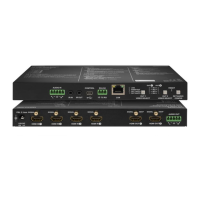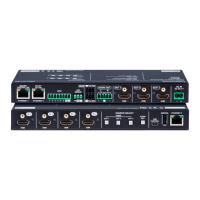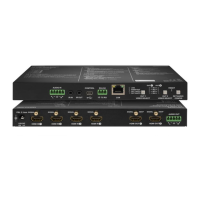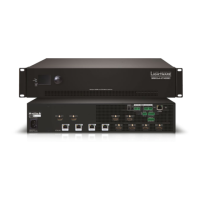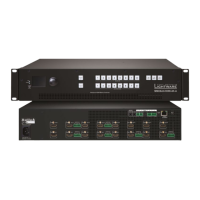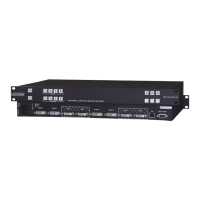Page 10 / 119 Section 1. Introduction
1.6. Features
6x2 multiport matrix switcher – The compact MMX6x2-HT220 has 6 video inputs
and 2 video outputs (4x HDMI 1.4 and 2x TPS inputs and 2x independent HDMI
outputs which are also mirrored as TPS ports).
3D and 4K support – High bandwidth allows extension of resolutions up to 4K and
even 3D sources and displays are supported.
Signal transmission up to 170 m – Video and audio signal transmission (DVI,
HDMI, Ethernet, RS-232 and Infra-Red over a single CAT5e…CAT7e cable.
HDCP compliant – MMX6x2-HT family fulfills the HDCP standard. HDCP
capability on the digital video inputs can be disabled when non-protected content
is extended.
Built-in Event manager – The Event Manager tool takes care of all the necessary
control in a smaller configuration by performing predefined actions in response to
device status changes. Hence, in a less complex environment, there is no need to
invest in additional control solutions, which makes the MMX6x2-HT device series
the best choice for numerous applications.
Advanced EDID management – User can emulate any EDID on the input ports,
read out and store any monitor's EDID in the internal memory.
Pixel Accurate Reclocking – Removes jitter caused by long cables; the output
has a clean, jitter free signal, eliminating signal instability and distortion caused by
long cables or connector reflections.
Frame detector and signal analysis – Using Lightware Device Controller
software the exact video and audio signal format can be determined such as timing,
frequencies, scan mode, HDCP encryption, color range, color space and audio
sample rate.
Remote power – The matrix is PoE-compatible and able to send remote power to
connected TPS devices via the TPS connection (through the CATx cable). No local
power adaptor required for the connected PoE-compatible TPS extender.
Autoselect function for video inputs – The Autoselect feature can sense the
ports status on the video input ports and select automatically one of them. Each
input ports can be set with a priority number and the feature allows to set a different
kind of priority list when the microcontroller selects the input port.
Front panel control – Every source and destination have their own button on the
front panel. Single switches can be executed or crosspoint presets can be saved
and reloaded. The most important settings can be configured through the front
panel LCD menu.
Ethernet control – Multiple simultaneous TCP/IP connections are available with
a simple ASCII-based protocol for controlling, configuring the matrix router or
perform a firmware upgrade.
USB control – Easily accessible front panel USB port in order to have a quick
connection to the matrix, and control with Lightware Device Controller Software.
Built-in power supply – Accepting AC voltages from 100 to 240 Volts with 50 or
60 Hz line frequency on a standard IEC connector.
Legendable buttons – Each button has a removable flat cap and a translucent
label which can be inserted under it to identify sources and destinations.
Non-volatile memory – The matrix router starts with its latest configuration
settings when powered on or after a power failure. Every setting is stored in a non-
volatile memory.
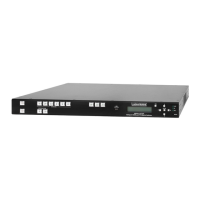
